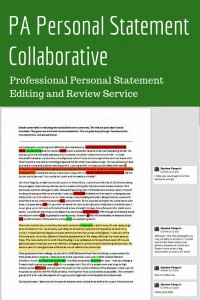
Email is unequivocally the number one technology you must be brilliant at if you are to succeed throughout the PA school interview or job application process.
For that reason, you need to be VERY careful when you use email as part of a job search effort or part of your PA school application process.
It is the primary vehicle by which you will network, apply, follow up, send thanks, and negotiate your offer. What does that mean for you?
It can only mean one of two things: You are already fluent with formal email communication techniques and this is good news OR you need to learn new skills in order to land the job or get into the PA school of your dreams.
It's likely you fall into category number two, and job-search related emails today may be hurting your odds of winning a job or getting that coveted acceptance letter.
If you have grown accustomed to instant messaging, be aware that this abbreviated form of language in an email is always perceived as disrespectful.
The Solution
First, put yourself in the shoes of the email recipient.
This should be easy because you have received emails that range from excellent to those you can’t wait to delete. For job search scenarios, your recipients are extremely busy, paging through hundreds of emails per day, and have multiple priorities aside from hiring this one position. Even worse, they feel huge pressure to hire the best candidate, as the cost of a bad hire is very high. So they have little to no tolerance for poorly written emails.
Second, pretend you are standing in front of them or in front of a hiring committee reading your email.
Additionally, visualize that each of them has your email in front of them in printed version. So you should aspire to come across clear, confident, knowledgeable, and capable of filling their position.
Finally, your emails are a reflection of how your documentation will be if you are hired for that job.
Therefore, if you have typos, are too casual, or have grammatical errors, their only assumption is that you are sloppy, illiterate, careless and not detail oriented. Not good traits of a healthcare provider.
Naturally, this works in your advantage if your emails are perfect. Candidates, they need to be perfect. Every time.
Requirements for job search related emails (any email, not just cover letters):
Write to a Specific Person. When emailing companies or a recruiter or networker for a job or as part of your application you should send your email to a specific person rather than the “info” or “HR” address. You’ll get a lot more responses this way.
If you have a person’s name but not their email address, direct the “info@” email to your person in the subject and salutation (Dear Mr. Smith) with the hopes that the company recipient will forward it to him. Job seekers may be able to locate the right person online. Search the web or LinkedIn. Even an attempt is better than the lousy “Dear Sir” or “Dear Madam.”
Make the Subject Line Work for You. The best subject lines are “Applicant for Job #######, Sarah Jones” or “Sarah Jones Credentials for Job Posting #####” or “Marketing Manager at GE, <Position Code> - Sarah Jones.”
Blank subject lines or generic ones like “Job Applicant” can go into spam or be the victim of the dreaded delete button. Real examples of poor ones I have received are “interested in your job” and “Hire Me!”
Salutations must be Formal. The salutation should be Dear Ms./Mr. Johnson. If you don’t have a name, then use “Dear Hiring Manager.”
Formal Business Letter Structure: If you are a novice at writing business letters, then go to Microsoft.com and type “business letter template.” There is a structured format. Your email body should essentially be a cover letter explaining who you are and why you would be good for the position. It is okay to have the cover letter in the body of the email as well as attached.
Complete Email Signature is Very Important: The signature block in your email can be automatically set in your email program of choice. Most candidates just sign “Bill” or “Bill Smith.” But, job seekers, the outcome you want with your email is for the reader to forward it to other people within their company, right? So put your email address in the signature, since it will be lost once your email is forwarded. Add your phone, your address, and your LinkedIn profile link, if you have one.
Send from a PC: Mobile devices will be used more and more in the job search process over the next 5 years. However, today, do NOT send a job search communication of any type via your mobile phone. It gives the perception that you are conducting your job search from a car, walking down the street, or in between something else more important. Hiring managers don’t want to see “Sent from my Android Phone,” “sent from my iPhone,” etc. Most importantly, your signature bar is usually missing.
Tricks
1. “The Law of 3s:” Like phone etiquette, try to say no more than 3 things in an email, then close the email with your next step commitment. This will not only prevent you from rambling, but it will be helpful for the recipient to digest your main points.
2. Send your email to yourself first: There is no better way to wear the shoes of your recipient than to send the draft to you first. Open it, read it out loud to catch mistakes, and print it to see how it looks as a printed document. I guarantee you will find things to edit.
3. Count the number of times you use “I” versus “You.” Remember, this job search is not about you. This communication, regardless if it is an application, a network, or a follow-up, is all about them and how you believe you can be the best candidate and employee for them.
4. Write in Microsoft Word then copy to email: Write your business letter in Microsoft Word then copy and paste that letter into your email body. This accomplishes two things: one, you have a saved copy of your letter in your documents folder and, two, it will look nicer.
5. Proofread, proofread, and proofread again: Check for proper spelling, grammar, punctuation, capitalization, and typing errors. All recruiters and hiring managers continue to be amazed at the amount of typos, missing commas, and run-on sentences. How should you proofread?
- Read the email to yourself out loud.
- Send it to a friend or family member.
- Read it backward.
- Correct all red, blue, and green squiggles that Microsoft generates for you.
- Edit your email with Grammarly.
6. When following up, attach the old message(s): So often, when I receive a follow-up to a job inquiry, I get a fresh email from the candidate. “Ms. Manciagli, I sent you my résumé two weeks ago, and I am writing to follow up.” Always make it easy for the recipient to engage! Send your follow-up as a forward of the prior email. AND reattach any attachments, such as your cover letter and résumé.
7. Bullet points are king: Very few people like to pour through long, wordy emails. In the main body of your email, use bullet points to send your key points. The opening and closing sentences should be full sentences, but the core can be bullet points.
Mistakes
Mistake #1: Using spam blockers. Spam blockers are special systems (usually a program or a filter) that prevent spam from entering your email inbox. It typically requires people to fill out a form and ask for your permission before your email will go through. Disable it now! If recruiters, networkers, or employers want to reach you, do not make them work to get to you. Put up with a little spam during your job search, then you can enable a spam blocker once you are employed.
Mistake #2: Happy faces. Never, ever, ever, ever put a happy face or another symbol in a job search email.
Mistake #3: Stop all cute, trite, informal, colloquial, or otherwise “silly” phrases. No more, “Hiya, let’s chitchat, awesome, cool, thnx, take care, let’s grab coffee, pick your brain,” etc. Write as if you were talking to a senior executive sitting across from you in a business suit. Avoid exclamation points as well.
Mistake #4: Email address of “[email protected]” or “[email protected].” You can create a new, free email account for your job search on Gmail.com or elsewhere, and I recommend using your first and last name or something professional.
Mistake #5: Fonts are all over the place. From the opening through the signature block, assure the font style and size is all the same. It is okay to bold or underline a few keywords, but clean the document up!
Mistake #6: Assuming that some communications don’t need to be so formal since they are “only going to the HR person” or “this is just a follow-up to a recruiter’s screener so it doesn't need to be so fancy.” Everything you write and will write can be used against you.
Mistake #7: Contractions. “I’m” should be “I am,” and “you’re” should be “you are.” You got the point.
Mistake #8: Acronym Abyss. Follow the main rule of acronyms: For the first use, always write out the words then put the acronym in parenthesis following. If you are communicating that you were an SE for 5 years, then you need to write out “Systems Engineer (SE)” for the reader. Best is to avoid industry-specific or company-specific acronyms.
Mistake #9: Forgetting the attachments. The new Microsoft Office 2013 and Office 365 have a new feature in Outlook, at “attachment reminder” with a prompt that says, “You may have forgotten to attach a file.” It has saved me numerous times. Just slow down; review your email prior to pushing “send.”
If you have a recommendation for email etiquette please let us know in the comments section below.
View all posts in this series
- My PA School Interview: The Journey of a Lifetime
- The Top 46 Physician Assistant Applicant Interview Questions
- Use this Interview Hack to Get The Physician Assistant Job of Your Dreams!
- The Physician Assistant Job or PA School Interview – Email Etiquette
- The Physician Assistant Interview: Thank You and Follow-up (With Sample)
- Your Main Goal on Your Path to PA Shouldn’t be Immediate Success or Money, But to Learn as Much as Possible
- A Look Inside Two PA School Interviews
- 5 Things I’ve Learned Going Into My Fourth Physician Assistant Application Cycle
- Use VisualCV to Create a Stunning Physician Assistant Resume
- 300 PA School Interview Questions You Should Be Ready to Answer
- PA School Mock Interviews: Prepare with a LIVE, Recorded Video Interview
- The 10 Best Websites for Physician Assistant Job Search in 2024
- The 10 Best Cities for PAs to Move to in 2024
- Mock Physician Assistant School Interview With Taylor Hill Pre-PA
- Mock PA School Interview With Pre-PA Lily Boyle
- 10 Reasons Why Physician Assistant/Associate (PA) is the #2 Healthcare Job in 2024
- The Interview That Got This Pre-PA Into 5 PA Schools
- 101 PA School Applicants Answer: What’s Your Greatest Strength?
- Mastering Your PA School Interview: Tone Matters
- The Worst PA School Interview Question Ever!
- How to Write the Perfect Physician Assistant Cover Letter
- Why Choose PA Over NP? Here’s the Perfect Answer
- Don’t Make This Critical PA School Interview Mistake!
- 5 Best Ways to Give a Memorable PA School Interview
- 3 Things to Do the Night Before Your PA School Interview
- How to Prepare for Your PA School Interview Day Essay
- The 4 Most Common Reasons PAs Quit Their Jobs
- How to Squash PA School Interview Day Stress (4 Simple Steps)
- Mind Mapping: A Tool for Personal Statements, Supplemental Essays, and Interviews
- Here’s What a REAL PA School Interview Looks Like (in 2024)
- My PA School Interview Preparation Strategy
- How to Bring Your Best on PA School Interview Day
- How to Cope with PA School Application Rejection
- ChatGPT Answers the Top 46 PA School Applicant Interview Questions
- Why Our Program? How to Answer This Common Supplemental Essay and Interview Question
- What is a PA? How to Nail This Not-So-Easy Interview Question
- How to Answer Behavioral Questions in Your PA School Interview















Leave a Reply